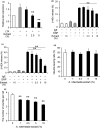Amelioration of atopic-like skin conditions in NC/Tnd mice by topical application with distilled Alpinia intermedia Gagnep extracts
- PMID: 28815692
- PMCID: PMC5697676
- DOI: 10.1111/1346-8138.13995
Amelioration of atopic-like skin conditions in NC/Tnd mice by topical application with distilled Alpinia intermedia Gagnep extracts
Abstract
Alpinia intermedia, a perennial plant that belongs to the Zingiberaceae family, has been used in folk medicine for a long time in the southern region of Japan. Because skin care is an effective approach that enables patients to manage their atopic dermatitis (AD), various herbal ingredients with few adverse effects have been evaluated for use in AD patients in recent years. In this study, we examined whether distilled extracts obtained from A. intermedia were beneficial for AD-like skin conditions in NC/Tnd mice. Topical application with the A. intermedia extracts significantly reduced the severity of AD, transepidermal water loss and scratching behavior in the mice. Supplementation of the extracts to cell cultures suppressed the expression of Tslp mRNA in PAM212 keratinocytes, degranulation in bone marrow-derived cultured mast cells (BMCMC), and neurite outgrowth in PC12 cells and dorsal root ganglia. In addition, the component analysis revealed that β-pinene was a major constituent of the A. intermedia extracts. The inhibitory effects of β-pinene both in vivo and in vitro were also demonstrated. These results indicate that topical application with the A. intermedia extract to the skin of NC/Tnd mice improved the condition of the skin by suppressing multiple inflammatory responses. The extracts may become novel skin-care remedies for AD patients.
Keywords: Alpinia intermedia; NC/Tnd mouse; atopic dermatitis; skin care; β-pinene.
© 2017 The Authors. The Journal of Dermatology published by John Wiley & Sons Australia, Ltd on behalf of Japanese Dermatological Association.
Figures





References
-
- Ring J, Alomar A, Bieber T et al Guidelines for treatment of atopic eczema (atopic dermatitis) part I. J Eur Acad Dermatol Venereol 2012; 26: 1045–1060. - PubMed
-
- Schmid‐Ott G, Jaeger B, Kapp A, Werfel T. Different expression of cytokine and membrane molecules by circulating lymphocytes on acute mental stress in patients with atopic dermatitis in comparison with healthy controls. J Allergy Clin Immunol 2001; 108: 455–462. - PubMed
-
- Palmer CN, Irvine AD, Terron‐Kwiatkowski A et al Common loss‐of‐function variants of the epidermal barrier protein filaggrin are a major predisposing factor for atopic dermatitis. Nat Genet 2006; 38: 441–446. - PubMed
-
- Cork MJ, Danby SG, Vasilopoulos Y et al Epidermal barrier dysfunction in atopic dermatitis. J Invest Dermatol 2009; 129: 1892–1908. - PubMed
MeSH terms
Substances
LinkOut - more resources
Full Text Sources
Other Literature Sources
Medical
Molecular Biology Databases

